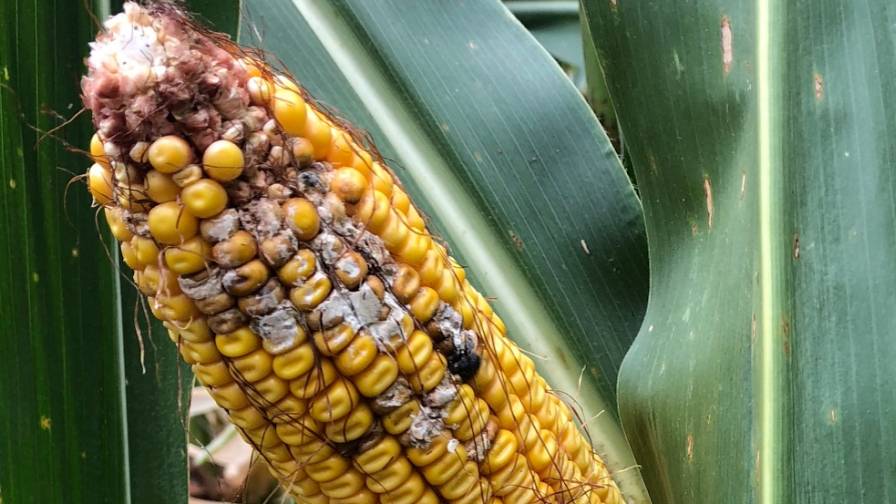Gypsum Added To List Of Conservation Practices
Crop farmers in a growing number of states may be eligible for financial assistance from the USDA’s Natural Resources Conservation Service (NRCS) to amend soils with gypsum, says Ron Chamberlain, lead agronomist and director of research for the GYPSOIL Division of Beneficial Reuse Management, Chicago. Chamberlain explained the new NRCS program to farm writers and broadcasters at Info Expo at Ag Media Summit, July 25-26 in St. Louis.
Wisconsin is a recent addition in a list of five states where NRCS authorities have adopted all or parts of a new national Conservation Practice Standard called AMENDING SOIL PROPERTIES WITH GYPSUM PRODUCTS CODE 333. The national code was approved in June of 2015. Other states with gypsum programs include Ohio, Indiana, Alabama and Michigan. The four purposes include:
- Improve soil health by improving physical/chemical properties and increasing infiltration of the soil;
- Improve surface water quality by reducing dissolved phosphorus concentrations in surface runoff and subsurface drainage;
- Improve soil health by ameliorating subsoil aluminum toxicity; and
- Improve water quality by reducing the potential for pathogens and other contaminants transport from areas of manure and biosolids application.
Specific guidelines for each state’s program can be found in NRCS’ Field Office Technical Guide by looking within each state’s Section IV.
In most cases, financial assistance for applying gypsum is available through conservation programs such as Environmental Quality Incentives Program (EQIP) or other water quality grant intiatives in at-risk watersheds and locations.
The Wisconsin NRCS has adopted the standard as an interim program for farmers and landowners in the Lower Fox River Basin, which includes all or parts of Brown, Calumet, Outagamie and Winnebago counties, says Chamberlain. The program is available through the Great Lakes Restoration Initiative for phosphorus reduction priority watersheds. Farmers and landowners who are interested in this program should talk with their local NRCS staff.
“Wisconsin NRCS follows an integrated systems approach for amending soils with gypsum,” says Chamberlain. “A farmer who is no-tilling, seeding cover crops and applying gypsum may realize additional benefits.”
How Gypsum Helps
Phosphorus binds with soil particles so soil erosion and runoff can carry phosphorus into creeks, rivers and lakes. Amending soils with gypsum can help reduce phosphorus levels in bodies of water, Chamberlain explains. GYPSOIL sells gypsum to farmers in 21 states in the Midwest, Mid-South and Southeast.
Gypsum (CaSO4Ÿ2H2O) contains about 20 percent calcium and 16 percent sulfur in sulfate form on a dry matter basis, however nutrient values vary depending on the specific source of the product. Beyond providing valuable nutrients, soil scientists have observed gypsum can improve the physical properties of certain soils, particularly those with high clay content. The calcium in gypsum helps to build soil aggregates and create pore spaces within the soil profile.
“Gypsum makes changes to soil structure by altering soil chemistry,” says Chamberlain. “The sulfate in gypsum binds with excess magnesium in the soil to form soluble Epson salts which are flushed out of the soil profile.” Magnesium is then replaced by the gypsum’s calcium to improve water holding capacity, root development and soil structure, explains Chamberlain.
“When magnesium and calcium are balanced, soil structure typically improves and farmers see less compaction and problems with runoff, ponding and erosion,” Chamberlain says.
Joe Nester, an independent agronomist and owner of Nester Ag, based in Bryan, OH, has recommended gypsum for many years to his clients. Many of the growers he works with operate in the Western Lake Erie Basin where tight, clay-based soils are prone to runoff, ponding and soil particle loss during rain events if not properly managed. Nester joined Chamberlain at the Ag Media Summit to discuss soil quality practices and his observations of gypsum’s impact.
Nester recalled a field day in 2002 where now-retired USDA researcher Darrell Norton used a rainfall simulator to demonstrate that gypsum-treated soils behaved differently than untreated soils, even with similar tillage. Treated soils absorbed more water and lost less soil sediment when rain was set to replicate a typical Midwest rainfall event.
“A light bulb turned on in my head,” says Nester. “When water runs through soils, it pulls air into the soil with it. That’s the magical part that creates the soil life.”
Nester recommends gypsum to clients to deliver calcium to tight clay soils and at same time to leach magnesium. He aims for soil test values of 12 to 15 percent base saturation for magnesium and at least 65 to 70 percent calcium, particularly for heavier soil with some clay content. Nester says when test numbers move closer to those levels, soil physical properties begin to improve. Nester is careful to point out that gypsum is neutral in pH so it does not replace agricultural lime used to change soil pH.
Soil And Water Quality
Three years ago Nester was tapped by soil scientists at The Ohio State University to coordinate on-farm sampling in a multiyear study to measure impacts of gypsum applications on water quality. The on-going study has shown that gypsum applications decrease concentrations of soluble reactive phosphorus (SRP) in tile water by 30-50 percent. This demonstrates gypsum’s potential as an effective tool to help reduce the amount of phosphorus running off farm fields into sensitive waterways, says Nester. The OSU findings, as well as other studies at land grant universities and the USDA, were the basis for NRCS’ new Conservation Practice Standard.
Recently Nester noticed stark visual differences in soybeans with and without gypsum treatments that he informally observed as part of Ohio State’s edge of field monitoring studies. He explains that after a period of heavy rainfall – 3.4” in five days — strips of soybeans where no gypsum was applied became yellowed and stressed. “Where we applied gypsum you could not see tile lines because there was considerable less stress on the crop,” Nester explains.
The emphasis on soil quality to manage runoff is a high priority in agriculture and financial assistance programs, such as the new NRCS Conservation Practice Standards to address gypsum use, will help growers evaluate new tools on their land.






